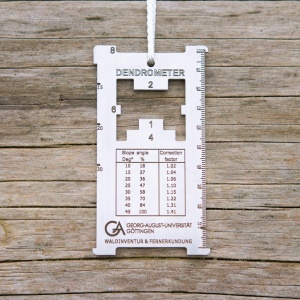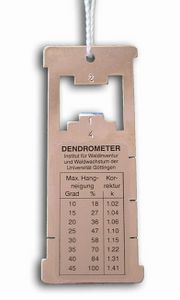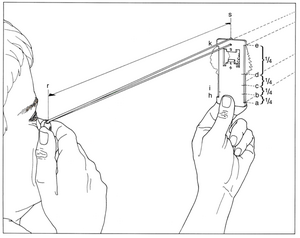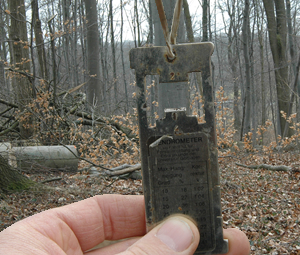Dendrometer
(→Estimating stem volume with "form height") |
(→Kramer's Dendrometer (Dendrometer II)) |
||
| (47 intermediate revisions by 4 users not shown) | |||
| Line 1: | Line 1: | ||
| − | ==Kramer's Dendrometer== | + | {{Ficontent}} {{video|link=https://youtu.be/wCbrwpTAYxI}} |
| − | [[File:dendrometer.jpg|thumb|Dendrometer]] | + | ==Dendrometer III== |
| − | The Dendrometer (according to [http://de.wikipedia.org/wiki/Horst_Kramer Kramer]) is a simple measurement device that is suitable for the estimation of [[basal area per hectare]], stand volume and rough estimates of tree height and volume partitioning of single trees (Kramer 1990<ref name="kramer">Kramer, H. 1990. Nutzungsplanung in der Forsteinrichtung. 2., überarbeitete und erweiterte Auflage. J.D. Sauerländer’s Verlag, Frankfurt/Main.</ref>, Akca 2001<ref name="akca">Akca, A. 2001. Waldinventur. J.D. Sauerländer's Verlag. Frankfurt am Main, 193 S.</ref>). The Dendrometer II | + | [[File:dendrometer_III.jpg|thumb|300px|New Dendrometer III]] |
| − | [http://www.uni-goettingen.de/en/67094.html Department of Forest Inventory and Remote Sensing] at the | + | From early 2025 onwards, the new Dendrometer III will be available. It is an evolution of the known Dendrometer proposed by Prof. Kramer (see below). A description and user manual is available at [https://doi.org/10.25625/USXNYO https://doi.org/10.25625/USXNYO]. |
| + | |||
| + | ==Kramer's Dendrometer (Dendrometer II)== | ||
| + | [[File:dendrometer.jpg|thumb|left|Kramer's Dendrometer II]] | ||
| + | [[File:dendrometer2.png|thumb|300px]] | ||
| + | [[File:dendrometer3.png|thumb|300px|Measurement of [[tree height]] and partitioning of volume]] | ||
| + | [[file:dendrometer01_wzp1.jpg|thumb|300px|BAF1]] | ||
| + | |||
| + | ==General description== | ||
| + | The Dendrometer (according to [http://de.wikipedia.org/wiki/Horst_Kramer Kramer]) is a simple measurement device that is suitable for the estimation of [[basal area]] per hectare based on the principle of [[Bitterlich sampling]], stand volume and rough estimates of tree height and volume partitioning of single trees (Kramer 1990<ref name="kramer">Kramer, H. 1990. Nutzungsplanung in der Forsteinrichtung. 2., überarbeitete und erweiterte Auflage. J.D. Sauerländer’s Verlag, Frankfurt/Main.</ref>, Akca 2001<ref name="akca">Akca, A. 2001. Waldinventur. J.D. Sauerländer's Verlag. Frankfurt am Main, 193 S.</ref>). The Dendrometer II was manufactured and distributed for more than 40 years by the | ||
| + | [http://www.uni-goettingen.de/en/67094.html Department of Forest Inventory and Remote Sensing] at the University of Göttingen based on details developed by Prof. Kramer in the early 1980s. Kramer's idea was to develop a simple and affordable alternative to the [[Relascope|Mirror Relascope]] developed based on Walter Bitterlich's invention of the "angle count method". A new Version of the Dendrometer (Dendrometer III) will be available from late 2024 or early 2025 onward and can be ordered via the [http://unishop.uni-goettingen.de/ Unishop] of the University of Göttingen. | ||
===Height measurement=== | ===Height measurement=== | ||
| − | It is possible to estimate tree height based on the [[geometric principle]] with the Dendrometer. Therefore hold the device vertically in front of the eye (opening on top) and aim at the tree to be measured. Adjust the distance of the Dendrometer from the eye or your distance from the tree until the points ''k'' and ''h'' correspond to the tree tip resp. to the bottom of the trunk. The relation of the section ''hi'' to line ''hk'' is 1:10. the height of point ''i'' corresponds to 1/10 of the tree height. In order to calculate the tree’s height measure the distance from ''i'' on the tree to the tree base and multiply by 10. | + | It is possible to roughly estimate [[tree height]] based on the [[The geometric principle|geometric principle]] with the Dendrometer. Therefore hold the device vertically in front of the eye (opening on top) and aim at the tree to be measured. Adjust the distance of the Dendrometer from the eye or your distance from the tree until the points ''k'' and ''h'' correspond to the tree tip resp. to the bottom of the trunk. The relation of the section ''hi'' to line ''hk'' is 1:10. the height of point ''i'' corresponds to 1/10 of the tree height. In order to calculate the tree’s height measure the distance from ''i'' on the tree to the tree base and multiply by 10. It should be considered that the measurement of tree heights is just a "side function" of this device, while the main purpose is in estimation [[basal area]]. |
| − | [[ | + | |
===Estimation of basal area per hectare=== | ===Estimation of basal area per hectare=== | ||
| − | The estimation of [[basal area]] is based on the principle of [[relascope sampling]] invented by [http://de.wikipedia.org/wiki/Walter_Bitterlich Walter Bitterlich] (Bitterlich 1952<ref name="bitterlich">BITTERLICH, W., 1952. Die Winkelzählprobe. Forstwissenschaftliches Centralblatt, 215-225.</ref>). | + | The estimation of [[basal area]] is based on the principle of [[Bitterlich sampling|relascope sampling]] invented by [http://de.wikipedia.org/wiki/Walter_Bitterlich Walter Bitterlich] (Bitterlich 1952<ref name="bitterlich">BITTERLICH, W., 1952. Die Winkelzählprobe. Forstwissenschaftliches Centralblatt, 215-225.</ref>). |
Aim at the dbh of each tree in a 360° sweep (from your standpoint). The basal area is a function of the angle and the number of stems which appear wider than the respective angle opening. Trees with width smaller than ''fg'' are not included in the sample (counted). | Aim at the dbh of each tree in a 360° sweep (from your standpoint). The basal area is a function of the angle and the number of stems which appear wider than the respective angle opening. Trees with width smaller than ''fg'' are not included in the sample (counted). | ||
| − | If you hold the dendrometer vertically at a distance of 50 cm before the eye ''r'' (distance to the eye is fixed with ''rs'' is 50 cm), then the plate with the width 1 creates an angle for which every counted tree corresponds to 1 m² basal area per hectare ([[basal area factor]] = 1). | + | If you hold the dendrometer vertically at a distance of 50 cm before the eye ''r'' (distance to the eye is fixed with ''rs'' is 50 cm), then the plate with the width 1 creates an angle for which every counted tree corresponds to 1 m² basal area per hectare ([[Bitterlich_sampling#Choice_of_basal_area_factor|basal area factor]] = 1). |
When a width of 2 or 4 is used, the resulting basal area (number of trees counted) must be multiplied by the corresponding factor (2 or 4) in order to obtain estimates of basal area per hectare. | When a width of 2 or 4 is used, the resulting basal area (number of trees counted) must be multiplied by the corresponding factor (2 or 4) in order to obtain estimates of basal area per hectare. | ||
With relascope sampling on slopes it is necessary to multiply the estimated basal area per hectare with the coefficient k (k=1/cos α) for the respective maximal inclination of slope from the table on the Dendrometer. | With relascope sampling on slopes it is necessary to multiply the estimated basal area per hectare with the coefficient k (k=1/cos α) for the respective maximal inclination of slope from the table on the Dendrometer. | ||
| − | |||
===Determining value of single trees by estimating volume sections=== | ===Determining value of single trees by estimating volume sections=== | ||
| Line 21: | Line 29: | ||
===Estimating stem volume with "form height"=== | ===Estimating stem volume with "form height"=== | ||
| − | For the 4 main tree species in northern Germany (Ei, Bu, Fi, Ki) and a given or measured mean stand height (''hm'') the "form-height factor" (FH-Tarif) can be read off the table on the dendrometer. Calculate stand volume per hectare in m³ including bark with the formula <math>V=G*FH</math>. | + | For the 4 main tree species in northern Germany (Ei, Bu, Fi, Ki) and a given or measured mean stand height (''hm'', which should be approximately the height of the mean basal area tree) the "form-height factor" (FH-Tarif) can be read off the table on the dendrometer. Calculate stand volume per hectare in m³ including bark with the formula <math>V=G*FH \,</math>. |
| + | |||
| + | ==Instruction manual for Dendrometer II== | ||
| + | Thanks to the input and efforts of many international researchers visiting our department, a lot of translations are available for the short instruction manual. It can be downloaded in: | ||
| + | |||
| + | *[[:File:Gebrauchsanleitung Dendrometer Englisch.pdf|English]] | ||
| + | *[[:File:Gebrauchsanleitung Dendrometer Deutsch.pdf|German]] | ||
| + | *[[:File:Gebrauchsanleitung Dendrometer Afrikaans.pdf|Afrikaans]] | ||
| + | *[[:File:Gebrauchsanleitung Dendrometer Albanisch.pdf|Albanian]] | ||
| + | *[[:File:Gebrauchsanleitung Dendrometer Arabisch.pdf|Arabic]] | ||
| + | *[[:File:Gebrauchsanleitung Dendrometer Chinesisch.pdf|Chinese]] | ||
| + | *[[:File:Gebrauchsanleitung Dendrometer Dänisch.pdf|Danish]] | ||
| + | *[[:File:Gebrauchsanleitung Dendrometer Französisch.pdf|French]] | ||
| + | *[[:File:Gebrauchsanleitung Dendrometer Griechisch.pdf|Greek]] | ||
| + | *[[:File:Gebrauchsanleitung Dendrometer Indonesisch.pdf|Bahasa Indonesia]] | ||
| + | *[[:File:Gebrauchsanleitung Dendrometer Italienisch.pdf|Italian]] | ||
| + | *[[:File:Gebrauchsanleitung Dendrometer Japanisch.pdf|Japanese]] | ||
| + | *[[:File:Gebrauchsanleitung Dendrometer Koreanisch.pdf|Korean]] | ||
| + | *[[:File:Gebrauchsanleitung Dendrometer Rumänisch.pdf|Romanian]] | ||
| + | *[[:File:Gebrauchsanleitung Dendrometer Russisch.pdf|Russian]] | ||
| + | *[[:File:Gebrauchsanleitung Dendrometer Slowakisch.pdf|Slovakian]] | ||
| + | *[[:File:Gebrauchsanleitung Dendrometer Spanisch.pdf|Spanish]] | ||
| + | *[[:File:Gebrauchsanleitung Dendrometer Türkisch.pdf|Turkish]] | ||
| + | *[[:File:Gebrauchsanleitung Dendrometer Ungarisch.pdf|Hungarian]] | ||
==References== | ==References== | ||
Latest revision as of 14:12, 21 November 2024
Contents |
[edit] Dendrometer III
From early 2025 onwards, the new Dendrometer III will be available. It is an evolution of the known Dendrometer proposed by Prof. Kramer (see below). A description and user manual is available at https://doi.org/10.25625/USXNYO.
[edit] Kramer's Dendrometer (Dendrometer II)
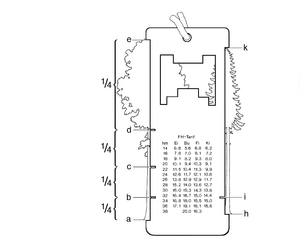
[edit] General description
The Dendrometer (according to Kramer) is a simple measurement device that is suitable for the estimation of basal area per hectare based on the principle of Bitterlich sampling, stand volume and rough estimates of tree height and volume partitioning of single trees (Kramer 1990[1], Akca 2001[2]). The Dendrometer II was manufactured and distributed for more than 40 years by the Department of Forest Inventory and Remote Sensing at the University of Göttingen based on details developed by Prof. Kramer in the early 1980s. Kramer's idea was to develop a simple and affordable alternative to the Mirror Relascope developed based on Walter Bitterlich's invention of the "angle count method". A new Version of the Dendrometer (Dendrometer III) will be available from late 2024 or early 2025 onward and can be ordered via the Unishop of the University of Göttingen.
[edit] Height measurement
It is possible to roughly estimate tree height based on the geometric principle with the Dendrometer. Therefore hold the device vertically in front of the eye (opening on top) and aim at the tree to be measured. Adjust the distance of the Dendrometer from the eye or your distance from the tree until the points k and h correspond to the tree tip resp. to the bottom of the trunk. The relation of the section hi to line hk is 1:10. the height of point i corresponds to 1/10 of the tree height. In order to calculate the tree’s height measure the distance from i on the tree to the tree base and multiply by 10. It should be considered that the measurement of tree heights is just a "side function" of this device, while the main purpose is in estimation basal area.
[edit] Estimation of basal area per hectare
The estimation of basal area is based on the principle of relascope sampling invented by Walter Bitterlich (Bitterlich 1952[3]). Aim at the dbh of each tree in a 360° sweep (from your standpoint). The basal area is a function of the angle and the number of stems which appear wider than the respective angle opening. Trees with width smaller than fg are not included in the sample (counted). If you hold the dendrometer vertically at a distance of 50 cm before the eye r (distance to the eye is fixed with rs is 50 cm), then the plate with the width 1 creates an angle for which every counted tree corresponds to 1 m² basal area per hectare (basal area factor = 1).
When a width of 2 or 4 is used, the resulting basal area (number of trees counted) must be multiplied by the corresponding factor (2 or 4) in order to obtain estimates of basal area per hectare. With relascope sampling on slopes it is necessary to multiply the estimated basal area per hectare with the coefficient k (k=1/cos α) for the respective maximal inclination of slope from the table on the Dendrometer.
[edit] Determining value of single trees by estimating volume sections
Set up the dendrometer in the same way as for height measurement. Through the markings b, c, d the stem is divided to 4 sections of equal volume.
[edit] Estimating stem volume with "form height"
For the 4 main tree species in northern Germany (Ei, Bu, Fi, Ki) and a given or measured mean stand height (hm, which should be approximately the height of the mean basal area tree) the "form-height factor" (FH-Tarif) can be read off the table on the dendrometer. Calculate stand volume per hectare in m³ including bark with the formula \(V=G*FH \,\).
[edit] Instruction manual for Dendrometer II
Thanks to the input and efforts of many international researchers visiting our department, a lot of translations are available for the short instruction manual. It can be downloaded in:
- English
- German
- Afrikaans
- Albanian
- Arabic
- Chinese
- Danish
- French
- Greek
- Bahasa Indonesia
- Italian
- Japanese
- Korean
- Romanian
- Russian
- Slovakian
- Spanish
- Turkish
- Hungarian
[edit] References
- ↑ Kramer, H. 1990. Nutzungsplanung in der Forsteinrichtung. 2., überarbeitete und erweiterte Auflage. J.D. Sauerländer’s Verlag, Frankfurt/Main.
- ↑ Akca, A. 2001. Waldinventur. J.D. Sauerländer's Verlag. Frankfurt am Main, 193 S.
- ↑ BITTERLICH, W., 1952. Die Winkelzählprobe. Forstwissenschaftliches Centralblatt, 215-225.
